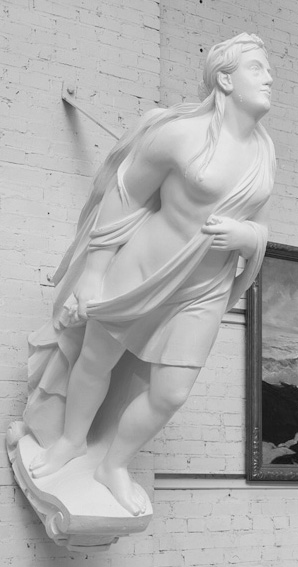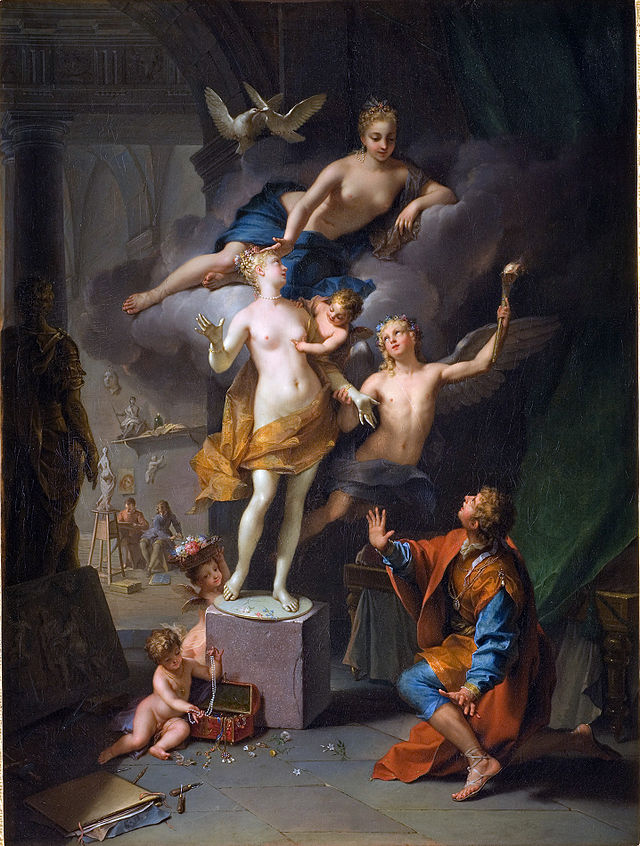For November I decided to make one of our beautiful figureheads the artifact of the month. Choosing one was rather difficult as they are all wonderful in their own ways, but eventually I picked that of Galatea.

I’ve found that, like Galatea here, a lot of figureheads get their names from mythology. There are two myths that go along with Galatea, the first stating that she was a beautiful sea goddess/nymph who was in love with a man named Akis. The cyclops Polyphemus was in love with Galatea and jealous of the young Akis, crushed him beneath a rock. In her grief, Galatea turned Akis into a stream.
The other myth refers to Galatea as a statue that Pygmalion carved from ivory. Pygmalion’s statue was so beautiful that he fell in love with it and left offerings to Aphrodite asking for a woman as wonderful as his statue. When he returned home his statue turned into a live woman and they were married.
I imagine that this figurehead was probably based on the latter story as she has been carved so smoothly that she looks as though she has been made of ivory. Also, when you compare paintings of Pygmalion and Galatea, she is usually shown with that same draping cloth across or around her, as with the image of the painting below.

While there has been some confusion as to which ship named Galatea that our figurehead came from, it has been determined that it is from the one built in 1865 in Boston. She was in American hands until 1877 when she her home port changed to Bremerhaven, Germany. She remained under German ownership until 1883, which is when she disappears from the European Lloyds Register of Shipping.
An interesting narrative of about the ship and the figurehead come from Captain Yngve Eiserman, a Swedish collector who gained his information from a local man who was part of the last crew on Galatea. He is stated as saying:
“The ship to which she gave her name was, I believe, one of the early American clippers whose memory is still honoured in the States. After making her name under the American flag she passed into German hands. Then one day in 1882, she was badly battered in a gale off Port Elizabeth…so the crippled Galatea crawled into Table Bay and was dry docked…the first ship to use the newly completed dock. But a sad blow fell upon the captain and his crew. Their ship was condemned as being no longer fit for sea. When the old Galatea was condemned she became a hulk in Table Bay. When she outlived her period of usefulness in even that lowly capacity she was run ashore among the breakers on Blaauwberg beach and broken up. Her figurehead, I believe, was saved by a Mr. Stevens at Blaauwberg. Eventually it passed into the ownership of Mr. Charles Bleach who set it up in his hotel at Simon’s Town. There it was always an object of interest…Now the American Museum has raised the money for its purchase and from letters I have said they are very glad over there to be getting it back. The figurehead, carefully packed, left in the American steamer West Isleta for New York on Thursday.”
As for who carved our figurehead, that is unknown, although it has been attributed to Herbert Gleason, who was a Boston carver. The reasoning is that Galatea shares many characteristics of known carvings by Gleason in look and form and because the ship was built in Boston.
In any case, she is a beautiful figurehead and while currently in storage, hopefully she will be displayed again in our Great Hall of Steam with some of the other figureheads.